Every day it seems as if we hear about a case of workplace violence. Most recently is the tragedy that occurred at the lawnmower parts factory in Kansas. Whether it’s a convenience store that’s been robbed or a shooting at a local elementary school, all employers need to be prepared.
The Statistics
First things first; let’s start with the statistics. According to the Bureau of Labor Statistics, 403 deaths were a result of workplace homicides in 2014 (latest data available). Among the workplace homicides in which women were the victims, the majority were committed by relatives or domestic partners (32 percent of those homicides). In workplace homicides involving men, robbers were the most common type of assailant (33 percent).
What is Violence?
Violence can encompass a myriad of behaviors that result in physical or psychological injury. Such behaviors include threats, verbal abuse, intimidation, harassment, suicides or near-suicides, and assaults up to and including homicide. The Occupational Safety & Health Administration (OSHA) provides information about workplace violence in Fact Sheets available on their website.
>> Jump to our contact form to receive more info on EAF membership
What are the Warning Signs?
There are common behaviors that indicate an individual is becoming or may become violent:
- Emotional outbursts that may include, swearing, crying and tantrums.
- Sudden changes in behavior and/or deterioration in job performance.
- Disregard for the safety and health of self or others.
- Disrespect for authority.
- Refusal to acknowledge job performance problems.
- Blaming others for mistakes.
- Pushing the limits to see what they can get away with. .
- Handles criticism poorly.
- Inability to focus.
- Complaints of unfair personal treatment.
- Talking about the same problems repeatedly without resolving them.
- Social isolation.
- Paranoid behavior.
- Holds grudges, especially against his or her supervisor. Verbalizes hope that something negative will happen to the person against whom he or she has the grudge.
Preventing Workplace Violence
Although unforeseen incidents of workplace violence can occur in the most diligent organization, employers can reduce the possibility of workplace violence by developing, implementing, and communicating prevention and intervention procedures. Human resources professionals, supervisors and managers should be responsible for monitoring employee behavior. Those behaviors, as indicated above, include altercations with coworkers, outbursts, and displays of threatening or intimidating behavior.
Preparing for a violent incident is a key component to identifying and preventing an event before it occurs. Formulating strategies for the prevention of workplace violence includes:
- Considering how each business decision will affect employees in the event of a downsizing, merger, acquisition, or other organizational change.
- Giving advance notice whenever possible to help employees adjust to organizational restructuring. Keep them informed about changes and provide additional benefits such as severance, counseling, and outpatient services if employees lose their jobs.
- Taking threats seriously and immediately investigating the circumstances. Threats are classified into three categories:
- Direct threat – Identifies a specific act against a specific target delivered in a straightforward, clear, and explicit manner.
- Conditional threat – It warns that a violent act will happen unless certain demands or terms are met.
- Veiled threat – is one that strongly implies, but does not explicitly threaten violence. Employers need to investigate all three types of threats, and not just assume that someone is just “blowing off steam” or will not follow through with the threat.
- Establishing a method for identifying problems in the work environment through employee opinion surveys or other communication vehicles. An adverse work environment can affect the stability of an emotionally distressed individual.
An effective workplace violence policy includes taking a zero-tolerance stance against intimidating, threatening or violent behavior. The policy also establishes a procedure for investigating potential problems. However, before such a policy can be implemented, it is important that there is:
- Commitment from top management to develop and enforce the policy.
- Training for supervisors on identifying and defusing problems and conflicts.
- A strong statement of the employer’s position prohibiting workplace intimidation, threats or violence.
- Written communication to all employees about the organization’s reporting procedures. An inside or outside “hotline” may give employees an avenue for anonymously submitting information.
- Penalties involved for employees found to have violated the policy, including immediate discharge.
- An optional search-and-inspection clause in the policy. Public or unionized employers may have other requirements to follow on search, seizure, or privacy rights.
- Decision regarding the use of “may” or “will” in the text of the policy. The use of ”will” can be a promise to act. An employer who states “complaints will be investigated” and does not proceed could face a negligence claim.
In addition to training supervisors and managers, it is very important to train all employees on:
- To whom they should report observed violent behavior;
- To whom they should report suspicious persons loitering on company property;
- How to respond in an active shooter situation;
- To whom should they report if they themselves are a victim of domestic violence and believe their “significant other” may be a threat them.
>> Jump to our contact form to receive more info on EAF membership
Secure workplace
While an organization may have implemented a comprehensive workplace violence policy, it does little good if the employer hasn’t ensured the facility itself has been secured to prevent violent individuals from accessing the workplace. For example:
If there are multiple ways to access your facility, is it possible to keep some of them locked so that individuals from outside the organization can’t come in a back door and take employees by surprise?
Is there a locked door between the lobby and the rest of the facility which would prevent someone from easily accessing the entire facility?
Is the parking lot well-lit?
Has a protocol been established for employees to walk out to their cars with a buddy, especially when working late into the evening?
While establishing barriers may not be easily accomplished in your facility, anything that can be done to impede the actions of a violent offender is important. More and more banks and convenience stores are installing glass walls as a barrier between cash-handling employees and anyone who could harm them. Similarly, most hospitals have implemented protocols requiring visitors to show their drivers’ licenses and be badged before accessing the main parts of the healthcare facility. Consider what these industries have done when renovating your facilities.
Legal Issues:
1) OSHA requires employers to maintain safe work environments for its employees. This would include reducing the risk of workplace violence by ensuring appropriate measures have been implemented to provide physical security of the facility itself. Additionally, there would be an expectation that threats of harm and/or physical assaults would be immediately addressed and stopped.
2) The employer could be sued for negligence if it did not take appropriate steps to provide a safe work environment for employees, customers, and other visitors to the facility.
3) Many states, such as Florida, have laws providing victims of domestic violence with time off from work in order to go to court, seek legal counsel, obtain medical attention, etc. It’s important for employers to review their state’s laws to see what obligations they may have to provide time off in these circumstances.
4) In the case of individuals who harass other individuals, the company could be subject to claims of discrimination under Title VII and/or state and local laws.
Workplace violence is a terrible issue that employers must be prepared to defend against. OSHA provides a number of tools to assist employers such as a workplace violence checklist and specific guides for industries such as healthcare, social services and retail which are more vulnerable to incidents of workplace violence.
Our People Experts at EAF are knowledgeable about workplace violence and can answer your organization’s pressing questions on this topic. To learn more about EAF’s hotline, please call or email us at 407.260.6556 or [email protected]
Interested in EAF Membership? Join now and receive 10% off NEW Member Dues!
Use PROMO CODE: EAFRocks on your Member Application.
(Promo expires August 31, 2016, restrictions apply)



